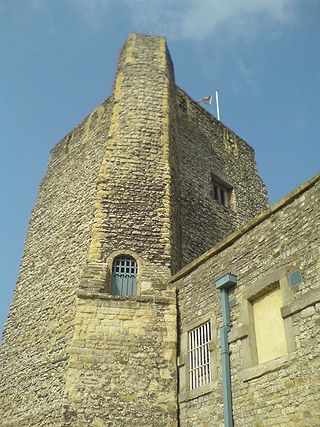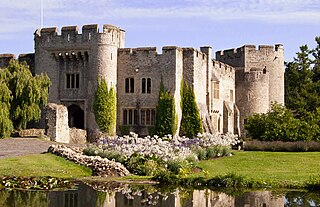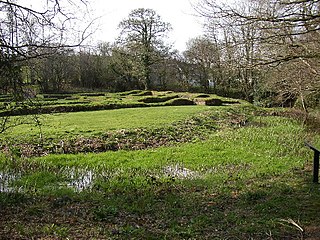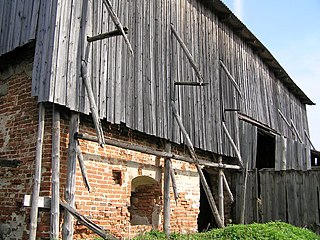Related Research Articles

Bretby Hall is a country house at Bretby, Derbyshire, England, north of Swadlincote and east of Burton upon Trent on the border with Staffordshire. It is a Grade II listed building. The name Bretby means "dwelling place of Britons".

Bretby is a village and civil parish in the south of Derbyshire, England, north of Swadlincote and east of Burton upon Trent, on the border between Derbyshire and Staffordshire. The population of the civil parish as of the 2011 census was 893. The name means "dwelling place of Britons". On the A511 road, there is a secondary settlement, Stanhope Bretby, which was the site of Bretby Colliery.

Bodiam Castle is a 14th-century moated castle near Robertsbridge in East Sussex, England. It was built in 1385 by Sir Edward Dalyngrigge, a former knight of Edward III, with the permission of Richard II, ostensibly to defend the area against French invasion during the Hundred Years' War. Of quadrangular plan, Bodiam Castle has no keep, having its various chambers built around the outer defensive walls and inner courts. Its corners and entrance are marked by towers, and topped by crenellations. Its structure, details and situation in an artificial watery landscape indicate that display was an important aspect of the castle's design as well as defence. It was the home of the Dalyngrigge family and the centre of the manor of Bodiam.

A battlement, in defensive architecture, such as that of city walls or castles, comprises a parapet, in which gaps or indentations, which are often rectangular, occur at intervals to allow for the launch of arrows or other projectiles from within the defences. These gaps are termed embrasures, also called crenels or crenelles, and a wall or building with them is described as crenellated; alternative older terms are castellated and embattled. The act of adding crenels to a previously unbroken parapet is termed crenellation.

A manor house was historically the main residence of the lord of the manor. The house formed the administrative centre of a manor in the European feudal system; within its great hall were usually held the lord's manorial courts, communal meals with manorial tenants and great banquets. The term is today loosely applied to various English country houses, mostly at the smaller end of the spectrum, sometimes dating from the Late Middle Ages, which currently or formerly house the landed gentry.

Powderham Castle is a fortified manor house in Exminster, Devon, 6 miles (9.7 km) south of Exeter and 1⁄4 mile (0.4 km) north-east of the village of Kenton, where the main public entrance gates are located. It is a Grade I listed building. The park and gardens are Grade II* listed in the National Register of Historic Parks and Gardens.

Robert D'Oyly was a Norman nobleman who accompanied William the Conqueror on the Norman conquest, his invasion of England. He died in 1091.

Allington Castle is a stone castle in Allington, Kent, just north of Maidstone, in England. The first castle on the site was an unauthorised fortification, built during "The Anarchy" (1135–1153) and torn down later in the century when royal control was reasserted. It was replaced by a manor house, which was fortified with royal permission in the 13th century. Various alterations and expansions were made by successive owners over the following two centuries. The property was developed into a fortified compound with six towers at irregular intervals along the curtain wall and domestic buildings in the interior, including one of the first long galleries built in England. In 1554 it was seized by the Crown in the course of dispossessing its owner, Sir Thomas Wyatt the Younger, after the failure of his rebellion against Queen Mary.

A gatehouse is a type of fortified gateway, an entry control point building, enclosing or accompanying a gateway for a town, religious house, castle, manor house, or other fortification building of importance. Gatehouses are typically the most heavily armed section of a fortification, to compensate for being structurally the weakest and the most probable attack point by an enemy. There are numerous surviving examples in France, Austria, Germany, England and Japan.

Penhallam is the site of a fortified manor house near Jacobstow in Cornwall, England. There was probably an earlier, 11th-century ringwork castle on the site, constructed by Tryold or his son, Richard fitz Turold in the years after the Norman invasion of 1066. Their descendants, in particular Andrew de Cardinham, created a substantial, sophisticated manor house at Penhallam between the 1180s and 1234, building a quadrangle of ranges facing onto an internal courtyard, surrounded by a moat and external buildings. The Cardinhams may have used the manor house for hunting expeditions in their nearby deer park. By the 14th century, the Cardinham male line had died out and the house was occupied by tenants. The surrounding manor was broken up and the house itself fell into decay and robbed for its stone. Archaeological investigations between 1968 and 1973 uncovered its foundations, unaltered since the medieval period, and the site is now managed by English Heritage and open to visitors.

Grosnez Castle is a ruined 14th-century castle in Saint Ouen, situated in Grosnez in the north-west corner of the island of Jersey in the Channel Islands. Philippe de Carteret held it against the French when they held half of Jersey between 1461 and 1467, but it has been a ruin since the mid-16th century.

Stephen de Segrave was a medieval Chief Justiciar of England.

Oakham Castle is a historic building in Oakham, Rutland. The castle is known for its collection of massive horseshoes and is also recognised as one of the best examples of domestic Norman architecture in England. It is a Grade I listed building. Owned and managed by the Rutland County Council, Oakham Castle is licensed for civil ceremonies. Admission to the castle is free.

Bury Castle was an early medieval moated manor house in Bury, Lancashire. Its remains are listed as a scheduled monument. The manor house was built by Sir Thomas Pilkington – lord of the manors of Bury and Pilkington, and an influential member of Lancashire's gentry – in 1469. He was given permission by Edward IV to:
"'build to make and to construct walls and turrets with stone, lime and sand around and below his manor house in Bury in the County of Lancaster, and to shut in the manor house with such manner of walls and turrets; also to embattle, crenellate and machicolate those towers."

Baltadvaris Castle was a fortified manor house, sometimes incorrectly described as a bastion castle, located about 2 kilometres (1.2 mi) west of Videniškiai in Molėtai District Municipality, Lithuania. Situated on the left bank of the Siesartis River, the castle was surrounded by the river on three sides.

A ringwork is a form of fortified defensive structure, usually circular or oval in shape. Ringworks are essentially motte-and-bailey castles without the motte. Defences were usually earthworks in the form of a ditch and bank surrounding the site.

Sir Edward Dalyngrigge, also Dallingridge or Dalyngridge, was a 14th-century knight and Member of Parliament who built Bodiam Castle in Sussex, England. By 1367, he had been knighted.

In Ireland at the end of the sixteenth and beginning of the seventeenth century, the fortified house, along with the stronghouse, developed as a replacement for the tower house. 'Fortified Houses' were often rectangular, or sometimes U or L-shaped, three-storey structures with high gables and chimney stacks and large windows with hood mouldings. Some examples have square towers at the corners. The interiors were relatively spacious with wooden partitions and numerous fireplaces. In a number of cases 'Fortified Houses' were built onto pre-existing tower houses. 'Fortified Houses' were protected by gun fire from the angle towers and bartizans, and were also provided with bawn walls with gunloops, towers and protected gateways. 'Fortified Houses' were built throughout Ireland by large landowners from a variety of backgrounds, such as the Old English Earl of Clanricarde who built Portumna Castle in County Galway; Gaelic lords such as MacDonogh MacCarthy, Lord of Duhallow, who built Kanturk Castle in County Cork; and Cromwellian soldiers such as Sir Charles Coote, who built Rush Hall in County Offaly.
Over the past six decades studies concerning Irish 'Fortified Houses' have identified them as a transitional genre that emerged at the end of the sixteenth century and acted as an architectural bridge between the Irish medieval tower-house and the country manor house of the late seventeenth century. The 'Fortified House' drew on the earlier tradition of the tower-house and was influenced by the Tudor and emerging Jacobean architecture from England and the Classical and Military architecture coming from Continental Europe. The social, political and military changes that took place from the 1580s-1650s were to play a major role in the development of this unique Irish structure. These houses provided a comfortable living space for the elite of early seventeenth-century Irish society. They were fashionable yet defendable. The 'Fortified House' was a public display of power and wealth. They represented a long term investment in their owner’s regional future and were monuments to an aspiration for an English and Continental house style suited to local Irish conditions. On a basic level the construction of a 'Fortified House' represented the owners’ desire to modernise and Anglicize.

Apley Castle was a medieval fortified manor in the village of Hadley, Shropshire, England.
This is a list of scheduled monuments in the district of South Derbyshire in the English county of Derbyshire.
References
- ↑ Historic England. "Bretby Castle fortified manor, Bretby (1011443)". National Heritage List for England . Retrieved 17 May 2017.